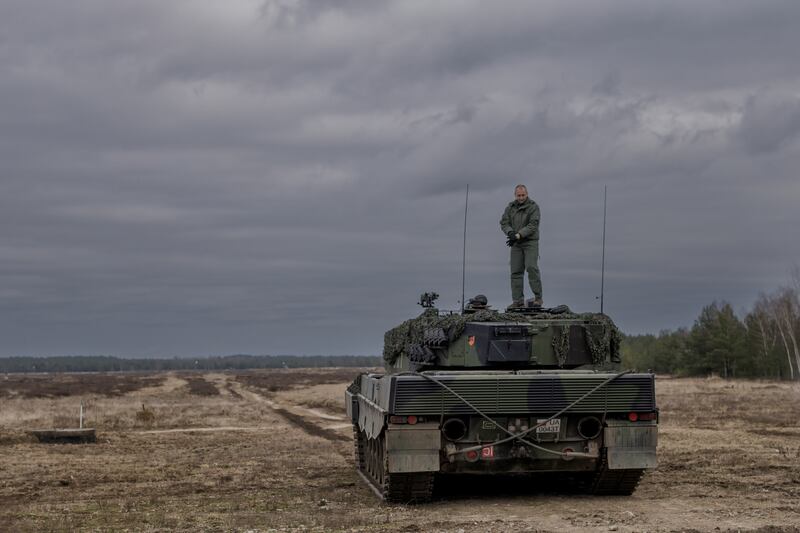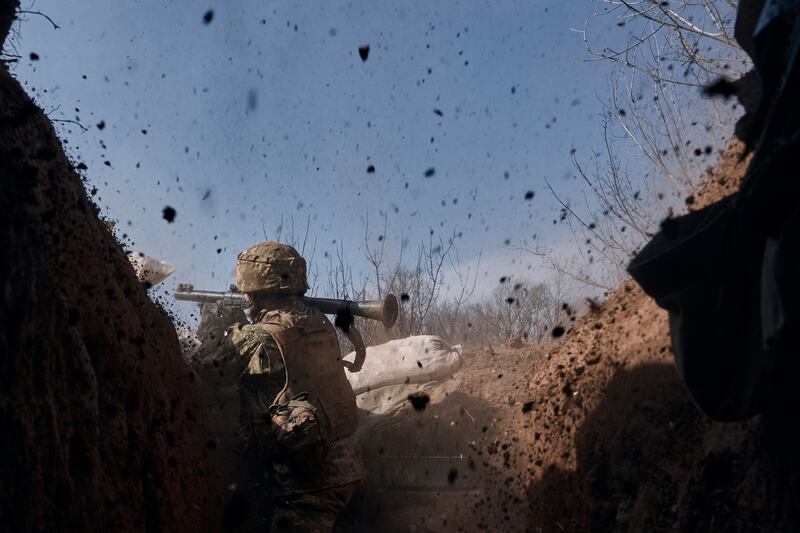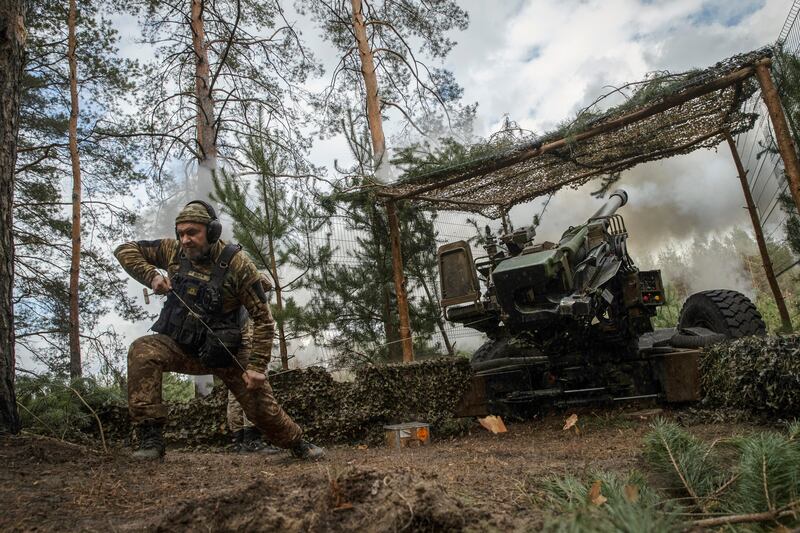It’s spring and heavy weapons flock to Ukraine like migrating birds. British Challenger 2 main battle tanks. French AMX-10 light tanks. From Germany, Leopard tanks and Marder fighting infantry vehicles. US Stryker troop carriers. More Leopards from Spain and Portugal...
“Ukraine is collecting forces for a counter-offensive in springtime,” Andriy Zagorodnyuk, former Ukrainian defence minister and director of the Centre for Defence Strategies in Kyiv, told a seminar on the strategic lessons of the war in Ukraine, organised by the Fondation Jean-Jaurès in Paris.
Ukraine wants to retain the element of surprise for the counter-offensive, as it did for lightning operations which retook much of the Kharkiv and Kherson regions last September. “We’re receiving a lot of equipment and support from the West in order to create a substantial force capable of breaking through the front lines,” Zagorodnyuk continues.
Despite a “scorched earth” strategy that left much of the eastern Donbas region in ruins, and Russian progress this week in the disputed city of Bakhmut, Zagorodnyuk says the Russian offensive has stalled and that Russian forces continue to take hundreds of casualties daily.
RM Block
“Putin is gambling his resources are greater than Ukraine’s, that the West will tire of the conflict. The West’s resources are greater than Putin’s, but only a fraction is available to us… Our job is to make sure the active phase of the war ends as soon as possible. We plan to push them out of our country this year.”

Ukraine has two advantages, the former defence minister says: the extreme centralisation of the Russian command, and “almost perfect” intelligence. “We know where their positions are down to platoons, tanks, armoured vehicles. We trace everything happening on front lines. We see where they are deploying and will be able to do surprise operations.”
Zagorodnyuk admits that the spring offensive will not be sufficient to liberate Ukraine. Western donors have promised 150 tanks, which will be deployed in one or two brigades. Brigades of 3,000 soldiers are the standard unit of the Ukrainian army.
Zagorodnyuk regrets that slow decision-making in the West has repeatedly delayed the arrival of military equipment. “If the tanks had been committed last June, they would have been delivered and we would be progressing with the counter-offensive already.”
A perceived but unfounded “escalation risk” often holds suppliers back, Zagorodnyuk says. “Self-deterrence is a constant challenge… Six months ago, tanks were considered escalatory. Rockets were escalatory. Even Himars [multiple rocket launchers], which are a normal thing on the battlefield, were considered escalatory.
“As soon as it’s done, things move and we say, ‘Okay. But you could have done this three, four or five months ago’… By the end of the year, I think we will see substantial innovations which were considered extremely escalatory months ago.”
Zagorodnyuk believes Russia will not carry out its threat to use nuclear weapons. “Strategic ambiguity doesn’t work with Russia. They need to understand exactly what will happen,” he says. The US has made the consequences of Russian first use perfectly clear, and China has also warned Putin against it.

Michel Goya, a historian, strategist and retired colonel in the French marines, told the seminar that the cost to Russia of using nuclear weapons would be enormous. “Would it be worth turning China and the entire world against them? I think only [the prospective loss of] Crimea might justify the use of nuclear weapons in Putin’s mind.”
Goya outlined the stages of the war so far. In the month following the full-scale invasion of Ukraine on February 24th, 2022, the Russians met fierce resistance from Ukraine but nonetheless managed to occupy much of the Kherson and Zaporizhzhia regions.
In the second phase, Russia tried to paralyse Ukraine with missile strikes and ate away at eastern Ukraine, conquering the cities of Mariupol, Severodonetsk and Lysychansk. “They sacrificed an infantry company for every square kilometre, a huge price to pay,” Goya says.
In the third phase, late last summer, the Ukrainian army reorganised around newly acquired western weapons and reconquered thousands of square kilometres in the Kharkiv and Kherson regions. Putin gave free rein to Yevgeny Prigozhin and his Wagner mercenary group. Russia mobilised 300,000 more troops and started another offensive in Donbas in December, while at the same time attempting to destroy Ukraine’s electricity network.
The Russian winter offensive is ending “with negligible strategic results, even if Bakhmut falls”, Goya says. But the Russian front is “more solid, more dense than last September. Russian forces have doubled. Last September they used mannequins to hide the shortage of manpower. Now they have men, but the quality is poor.” He predicts it would take three or four more successful Ukrainian offensives to break the Russian army.
Mélanie Rosselet, head of strategic analysis at the French atomic energy commissariat, noted that nuclear deterrence is working, since Russia dares not attack any Nato member.

But Russia indulges in what Rosselet calls “irresponsible nuclear rhetoric”. Three days after the invasion, Putin announced he was putting Russia’s nuclear forces on alert. In February, he suspended Russian adherence to New Start, the last nuclear weapons treaty with the US. On March 25th, he threatened to deploy tactical nuclear weapons in Belarus.
Russia’s nuclear arsenal enables it to practise “aggressive sanctuarisation”, Rosselet says. The term was coined by French expert Jean-Louis Gergorin in the 1990s to describe the use of a nuclear umbrella as protection when attacking another country. The Ukraine war poses the question of “how to prevent Russia sheltering behind its nuclear force to conduct a colonial conflict in defiance of international law”, she says.
Marie Dumoulin, director of the European Council of Foreign Relations, notes that it was Russia, not Ukraine, France and Germany, which prevented the 2014-2015 Minsk accords entering into force. Putin abrogated the accords when he recognised Luhansk and Donetsk (which together comprise Donbas) as autonomous republics and later annexed them.
Allegations that the West perpetuates the conflict by arming Ukraine, or that western powers could achieve a ceasefire, are wrong, Dumoulin said. There was a difference between a ceasefire “which would help Russia enormously” and a lasting resolution of the conflict.
Both countries believe their survival is at stake in this war. “The existential character of the war makes negotiations difficult or impossible,” Dumoulin says. “For the time being, both sides are in a scenario of total war. It cannot end until one side or the other decides that to preserve its existence it must accept a compromise. A third party cannot impose that.”
There are those who argue that Ukraine must eventually accept the loss of some territory to Russia. Dumoulin says that “Ukraine cannot say it would accept anything less than a return to its 1992 borders, and we cannot say we abandon the rights of a sovereign Ukraine.” A frozen conflict would be the worst scenario, “because refugees could not return home and Ukraine could not be a viable state under constant threat of a new Russian offensive.”
The Crimean Peninsula, which Russia invaded in 2014 and later annexed, could prove the most intractable element of the conflict. De facto annexation, but without international recognition, is a possibility, Dumoulin says. That would be a continual source of tension, but more manageable than war.























